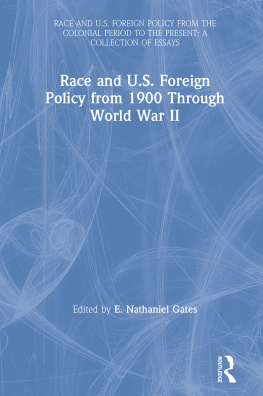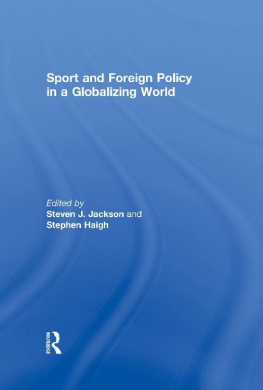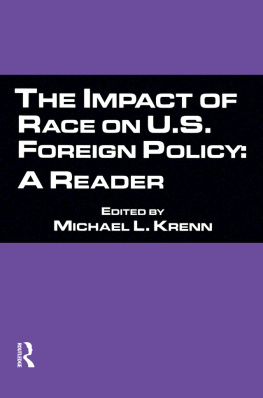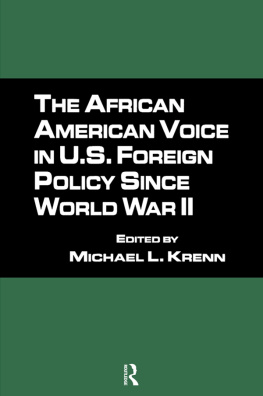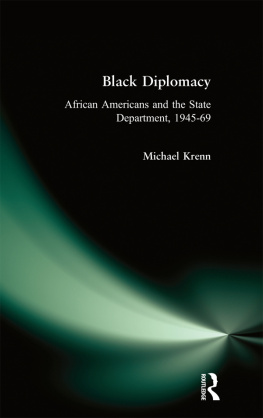Race and U.S. Foreign Policy from the Colonial Period to the Present
A Collection of Essays
Series Editor
Michael L. Krenn
University of Miami
Series Contents
- Race and U.S. Foreign Policy from Colonial Times through the Age of Jackson
- Race and U.S. Foreign Policy in the Ages of Territorial and Market Expansion, 1840 to 1900
- Race and U.S. Foreign Policy from 1900 through World War II
- Race and U.S. Foreign Policy during the Cold War
- The African American Voice in U.S. Foreign Policy since World War II
Race and U.S. Foreign Policy from 1900 through World War II
Edited with introductions by
Michael L. Krenn
University of Miami
First published 1998 by Garland Publishing, Inc.
Published 2019 by Routledge
2 Park Square, Milton Park, Abingdon, Oxon OX14 4RN
52 Vanderbilt Avenue, New York, NY 10017
Routledge is an imprint of the Taylor & Francis Group, an informa business
Introductions copyright 1998 Michael L. Krenn.
All rights reserved. No part of this book may be reprinted or reproduced or utilised in any form or by any electronic, mechanical, or other means, now known or hereafter invented, including photocopying and recording, or in any information storage or retrieval system, without permission in writing from the publishers.
Notice:
Product or corporate names may be trademarks or registered trademarks, and are used only for identification and explanation without intent to infringe.
Library of Congress Cataloging-in-Publication Data
Race and U.S. foreign policy from 1900 through World War II / edited
with introductions by Michael L. Krenn.
p. cm. (Race and U.S. foreign policy from the colonial
period to the present; 3)
Includes bibliographical references.
ISBN 0-8153-2957-1 (alk. paper)
1. United StatesForeign relations20th centuryCitizen
participation. 2. United StatesForeign relations20th century
Social aspects. 3. Afro-AmericansPolitics and government. 4.
Afro-AmericansHistory18771964. 5. United StatesRace
relations. 6. RacismUnited StatesHistory20th century.
I. Krenn, Michael L., 1957 . II. Series.
E744.R275 1998
305.8'00973dc21 98-21992
CIP
ISBN 13:978-0-8153-2957-2 (hbk)
Contents
David H. Burton
Robert W. Rydell
Brenda Gayle Plummer
William Jordan
Paul Gordon Lauren
Ben F. Rogers
William R. Scott
Robert G. Weisbord
Red Ross
David J. Hellwig
Akira Iriye
John W. Dower
Christopher Thome
Richard H. Minear
Thomas Hachey
Christopher Thorne
The interconnections between race and U.S. foreign policy have only recently come under the close scrutiny of scholars. Perhaps this has been due to the fact that, for many students of American diplomacy, race was seen as a distinctively domestic issue, encircled by debates over civil rights, affirmative action, and discrimination. Foreign policy, at least as it was studied for generations, was viewed as being somehow disengaged or insulated from such disturbing issues as the demeaning and sometimes violent attitudes of many white Americans toward black Americans and other minority groups, and from the sufferings and protests of those same groups. After all, it was reasoned, foreign policy involves analyses of international power relations, not the sometimes tawdry conflicts between bigots and their victims; it is made and implemented not by ignorant racists but by what some have called "the best and the brightest" people America has to offer. Foreign policy responded to the demands of the educated and powerful elite of the nation, it was admitted, not to the racial minorities marginalized by American society.
As the selections in these five volumes indicate, however, the study of race and U.S. foreign policy has taken on a life of its own. Spurred on in large part by the powerful civil rights movement of the 1960s, historians of America's foreign relations began to reconsider their conceptions of what the nation's foreign policy was and how it was made. New questions were asked: What were the views on race of America's diplomats, and did those views influence their words and actions? Did racism influence U.S. policies and programs directed toward peoples of color Native Americans, Latin Americans, Africans, Asians? What was racism's role in specific foreign policy actions Manifest Destiny and the war with Mexico; the Spanish-American War and the U.S. thrusts into the Pacific and the Caribbean; the "Big Stick" policies of one Roosevelt and the "Good Neighbor" policies of another; the war in the Pacific against Japan and the dropping of the atomic bombs; and America's Cold War interventions in the Third World, particularly in Vietnam? How did the African-American population of the United States develop a foreign policy outlook, and what effect did it have on issues such as the U.S. occupation of Haiti, the Italo-Ethiopian War, the U.S. attitude toward the decolonization of Africa, and U.S. relations with South Africa?
All of these are important questions as the United States begins planning for the twenty-first century. America's role in an increasingly shrinking world will continue to bring it face to face with different peoples and different cultures, even as the voices of the nation's ever-growing minority groups grow louder and louder with each passing decade. For what all of the selected essays indicate is that (racial) power struggles at home have very distinct parallels with the assertion of American power abroad. Being one of "the best and the brightest" does not make one immune from feelings of bigotry and racism (indeed, as an elite group, it has often played a large role in the definition and dissemination of racial doctrines). And even minority voices, when focused and well organized, can and do have an impact on America's foreign policy.
This present series of volumes, by bringing together the most important and informative scholarly works dealing with race and U.S. foreign policy published during the last fifty years, indicates the wide-ranging scholarly imagination and inquisitiveness of some of the discipline's leading minds. It is the editor's hope that the essays comprising this series will provoke further discussion and study of this increasingly important field of American history by serving as a research aid for both students and professionals alike.
The dawning of the twentieth century found the United States caught up in the reform and fervor of Progressivism, an ideology that sought to alleviate the problems of the new industrial America by the application of scientific principles that would rationalize the chaotic economic, political, and social changes engendered by the industrial revolution of the late nineteenth century. In terms of the nation's foreign policy, the changes were less dramatic. The expansion of markets and trade still dominated the outlook of many policymakers; but, swept up in the Progressive movement, there did seem to be more of a belief that practical and reasonable American policies overseas could bring a certain degree of uplift to our "little brown brothers" around the world as well as an increase of American profits.
As David Burton explains in his article, Theodore Roosevelt, as the first Progressive president, was a firm believer in the science of race and the theories of social Darwinism. These ideas carried over into his considerations of America's place in the world, providing both incentive and justification for his "big stick" outlook as it applied to his policies in Latin America and the Far East. Robert W. Rydell takes a different approach in his piece by examining the evidence of race and U.S. foreign policy on display at the 1904 World's Fair in St. Louis. In particular, he focuses on the exhibit of a Filipino village which, beyond its "entertainment" value, delivered a very powerful message. By displaying Filipino "savages" side by side with the more "Americanized" Filipinos, the exhibit made clear that U.S. intervention could uplift even the most backward and barbaric people to a level at which, while still far below the Anglo-Saxon standard, they could take their proper place in the world system. Woodrow Wilson, too, faced the issue of race and foreign policy, as the question of the rights of colonial peoples came up at the Paris Peace Conference at the end of World War I. As Paul G. Lauren argues, Wilson sidestepped this issue in order to pursue what he considered to be his larger goals of building a Progressive world out of the ashes of the war.


